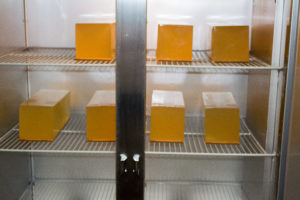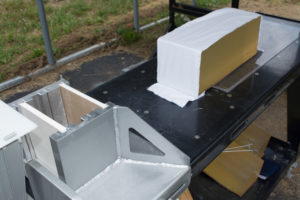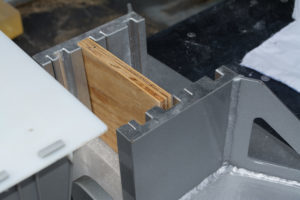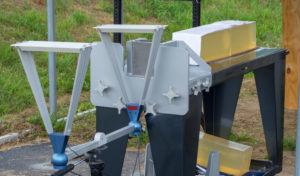FBI Ammunition Testing includes a variety of scenarios and mediums such as ballistic gel, heavy clothing and auto safety glass to see how ammunition responds. This can be a good selling point to customers if you understand the testing methods and can articulate them during a sale. (Photo: Tom McHale)
Customers often want to know your opinions on the performance of the products you sell. The problem with self-defense ammunition is that it’s tough to share personal experience details. Sure, you can shoot it for function and accuracy testing, but it’s considered bad form to go around shooting a bunch of people to see how effective it is at stopping determined evildoers. Law enforcement agencies have the same problem. When deciding what ammo to choose, they need a standardized way to evaluate the performance of different brands and loads objectively.
That’s where the FBI Ammunition Testing protocol comes into play. The Feeb Ballistic Gurus Lab Team developed a series of tests that attempted to replicate the performance of bullets when fired into human tissue after passing through common barriers that agents might encounter in the field. For example, a test might evaluate the performance of bullet fired through heavy clothing or automotive safety glass. To simulate the human part, testers use big blocks of stuff called ballistic gelatin.
All tests in the protocol measure bullet performance after it enters these blocks of 10 percent ballistic gelatin. Here’s a trivia fact to impress your friends: That 10 percent refers to the percent of Kind & Knox or Vyse 250-A ordnance gelatin to water by weight. It’s important to be able to compare results over time and space, so test conditions and parameters are meticulously defined. The gelatin blocks must be refrigerated at a temperature of 39.2 degrees Fahrenheit and used within 20 minutes of leaving that low-temp environment. Each block must be calibrated for consistency and density. This is tested by firing a .177 caliber BB into the block at a velocity of 590 feet per second give or take 15 fps on either side of that. If the BB penetrates to a depth between 2.95 to 3.74 inches, then that block is good to go.
The goal of all of this meticulous setup and testing is to make sure a bullet penetrates into the gelatin to an adequate depth while expanding as much as possible. The bullets must also retain as much of it's original weight as possible by staying together and not fragmenting or coming apart.

Ballistic gelatin is used most frequently to determine bullet expansion and depth, and gives insight about expended energy. Blocks must be stored fresh in refrigerators and used within specific temperature ranges to ensure consistency over time. (Photo: Tom McHale)
The tests call for a penetration depth of 14-16 inches to score maximum points. Bullets that travel less than 12 or more than 18 inches are penalized in the scoring. The tester measures bullet expansion diameter and weighs the recovered projectile to see what percentage of the bullet might have been lost due to fragmentation. After the measurements are recorded, the results are tabulated to develop overall performance scores based on all of these inputs.
Using this methodology, we have a standard way to objectively compare the performance of one bullet versus another just by comparing overall scores throughout the battery of tests. And, as we’ll see in a minute, results are observed and tabulated for each shooting scenario so we can see which bullets do well through clothing or maybe hard barriers like automotive safety glass.
In fact, most manufacturers rely heavily on these tests in the design stage of their defensive ammunition offerings. Knowing what law enforcement agencies expect, in detail and in advance allows companies to design, test, and tweak their products to get the best overall performance through a variety of simulated scenarios. As an example, the Sig Sauer Ammunition team destroys thousands of gelatin blocks to make sure their various calibers and loads perform properly in the tests.
“In the world of ammunition, standardization, consistency, and especially performance are all of the utmost importance," said Bud Fini, Executive Vice President, Ammunition & Special Projects. "Having the FBI protocol evaluation testing criteria as the ultimate benchmark provides SIG with the absolute knowledge that we are meeting or exceeding the most stringent testing parameters in use today. And, in order for SIG SAUER to meet the demands of this very sophisticated testing, we have created a world-class laboratory and test facility, to ensure that our manufacturing quality is always maintained at the highest level attainable."
The original FBI test suite originally included eight different scenarios, but most modern implementations use six as the last two are repeats of earlier tests at longer distances. Let’s take a quick look at all eight so you know what they are.

Note how the block of ballistic gelatin is positioned 18 inches behind the two-piece wallboard setup and also covered with light fabric. This configuation provides several pieces of information important to the final test report. (Photo: Tom McHale)
1. Bare Gelatin
The first test presents the easiest opportunity for ammunition to shine. With no barriers between the speeding bullet and ballistic gelatin block, there is no excuse for a bullet not to expand into a picture-perfect flower pattern. Five bullets are fired into the block from a distance of exactly ten feet measured from the muzzle to the leading surface of the gelatin. Sometimes the elasticity of the gelatin causes the bullet to bounce back at the end of its travel, so penetration is measured by the farthest distance traveled - kind of like forward progress in football.
Interestingly, a bullet may not perform as well on the penetration aspect in this scenario. The bare gelatin often encourages maximum expansion, and that tends to slow the bullet down faster so penetration may not be as deep. When barriers like heavy clothing or hard materials limit or slow expansion, a bullet may penetrate deeper.
2. Heavy Clothing
Like the first test and all the remaining ones, this one calls for five shots into a gelatin block also from a distance of ten feet. However, a heavy clothing material is placed in front of the block. Like everything else, the heavy clothing makeup is carefully specified. It’s composed of four layers of fabric as follows: cotton undershirt material, cotton dress shirt material, a layer of Polartec 200 fleece, and 14.4 pounce-per yard denim. At this part of the test, things start getting interesting as these layers of material just love to clog up hollow point bullets.

The wood scenario uses a single sheet of 3/4-inch plywood, which is frequently used for exterior walls on many structures. (Photo: Tom McHale
3. Steel
The next test simulates the weakest portion of an average car door. Two six by six-inch 20-gauge steel sheets are placed 3.5 inches apart, again ten feet from the muzzle. The gelatin block is exactly 18 inches behind the second steel sheet and covered with light fabric. Not coincidentally, this fabric barrier is the first two cotton materials used in the heavy clothing test.
4. Wallboard
Know what plugs up hollow point bullets really well? Drywall. Know what plugs them even worse? Two sheets of drywall - one-half-inch gypsum to be specific. That’s exactly what the fourth scenarios tests. With the exception of using drywall instead of steel, the rest of this test is identical to the previous one. If a bullet still manages to expand and penetrate after going through a simulated wall, 18 inches of clear space, two layers of cotton, and into the gel block, then it’s probably a pretty good one.
5. Plywood
To test potential residential obstacles, this test uses the same plywood that covers the exterior of many homes and buildings, three-quarter-inch thick AA Fir plywood. While materials can certainly vary widely, this serves as a proxy for all sorts of scenarios including exterior walls, wooden doors, or fences. Like the previous two tests, a gelatin block covered with light fabric layers is placed 18 inches behind the single piece of plywood.

In this test the bullet passes through two sheets of 20-gauge steel and light fabric. This test simulates a round being fired through a car door and light clothing. (Photo: Tom McHale)
6. Automotive Safety Glass
The law enforcement origin of these tests is clear with the automotive safety glass test. It’s intended to simulate a car windshield as officers have often had to shoot through that medium. Consistent with shooting through a windshield from beside the front fender, the one-quarter-inch laminated safety glass is oriented at a 45-degree angle to the ground. Then it’s turned 15 degrees to the side.
As you might guess, between the hard glass and angles, this is the toughest scenario of all. I’m not sure I’ve seen many, if any, bullets normally expand after passing through the safety glass. Usually, they get mashed and crushed in random ways. The best scenario is for the bullet to remain as intact as possible to retain maximum weight and penetrate to the target depth.
7. Heavy Clothing - At 20 yards
This test is indention to the second scenario except that the muzzle is 20 yards from the gelatin block. In most tests, the results are much the same as the 10-foot distance test as little velocity is lost in the first 20 yards of flight.
8. Automotive Safety Glass - At 20-yards
Besides the increased difference, there is one other change from the 10-foot scenario. The side 15-degree angle isn’t relevant here, so there is only the 45-degree from horizontal in the setup. In a street scenario that this test simulates, a car might be driving directly at a law enforcement officer who is standing right in front of the windshield.
We’ve focused on the penetration and expansion testing as those are the hardest to replicate at your local range. We should note that the FBI tests also include structured scenarios to test accuracy and velocity.
Clearly, it’s impossible to predict performance on the street against human targets in a lab because there are an infinite number of variables which influence whether a bullet will stop a determined adversary.
However, by developing and carefully standardizing this series of tests, it’s possible to compare basic performance characteristics between ammunition offerings. Many manufacturers will publish their results, but it may take some digging on the website or a call to the factory to get the results. Having some knowledge handy of how various loads perform in the FBI tests is a valuable selling aid.
More top picks from Shooting Sports Retailer:
Best tips for your computer's security and retail safety
Review: Browning .380 Auto Black Label Pro
First Look: CMMG's new ultra-compact BANSHEE lineup
Hiring range instructors: In-house or on a contract?
When it's raining lead, these rugged steel targets perform






